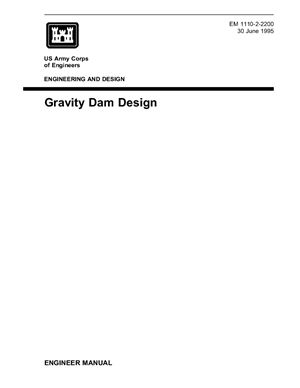Washington, Department of the Army, 1995, 88 pages.
This manual presents analysis and design guidance for concrete gravity dams.
The purpose of this manual is to provide technical criteria and guidance for the palnning and design of concrete gravity dams for civil works projects.
Table of contents
Chapter 1: Introduction
Purpose
Scope
Applicability
References
Terminilogy
Chapter 2: General Design Considerations
Types of Concrete Gravity Dams
Coordination Between Disciplines
Construction Materials
Site Selection
Determining Foundation Strength
Parameters
Chapter 3: Design Data
Concrete Properties
Foundation Properties
Loads
Chapter 4: Stability Analysis
Introduction
Basic Loading Conditions
Dam Profiles
Stability Considerations
Overtuing Stability
Sliding Stability
Base Pressures
Computer Programs
Chapter 5: Static and Dynamic Stress Analyses
Stress Analysis
Dynamic Analysis
Dynamic Analysis Process
Interdisciplinary Criteria for Response to Site-Dependent Earthquakes
Geological and Seismological Investigations
Selecting the Controlling Earthquakes
Characterizing Ground Motions
Dynamic Methods of Stress Anasysis
Chapter 6: Temperature Control of Mass Concrete
Introduction
Thermal Properties of Concrete
Thermal Studies
Temperature Control Methods
Chapter 7: Structural Design Considerations
Introduction
Contraction and Construction Joints
Waterstops
Spillway
Spillway Bridge
Spillway Piers
Outlet Works
Foundation Grounting and Drainage
Galleries
Instrumentation
Chapter 8: Reevaluation of Existing Dams
General
Reevaluation
Procedures
Considerations of Deviation from Structural Criteria
Structural Requirements for Remedial Measure
Methods of Improving Stability in Existing Structures
Stability on Deep - Seated Failure Planes
Example Problem
Chapter 9: Roller - Compacted Concrete Gravity Dams
Introduction
Construction Method
Economic Benefits
Design and Construction Considerations
Appendix A: References
Appendix B: Glossary
Appendix C: Derivation of the General Wedge Equation
Appendix D: Example Problems - Sliding Analysis for Single And Multiple Wedge Systems
This manual presents analysis and design guidance for concrete gravity dams.
The purpose of this manual is to provide technical criteria and guidance for the palnning and design of concrete gravity dams for civil works projects.
Table of contents
Chapter 1: Introduction
Purpose
Scope
Applicability
References
Terminilogy
Chapter 2: General Design Considerations
Types of Concrete Gravity Dams
Coordination Between Disciplines
Construction Materials
Site Selection
Determining Foundation Strength
Parameters
Chapter 3: Design Data
Concrete Properties
Foundation Properties
Loads
Chapter 4: Stability Analysis
Introduction
Basic Loading Conditions
Dam Profiles
Stability Considerations
Overtuing Stability
Sliding Stability
Base Pressures
Computer Programs
Chapter 5: Static and Dynamic Stress Analyses
Stress Analysis
Dynamic Analysis
Dynamic Analysis Process
Interdisciplinary Criteria for Response to Site-Dependent Earthquakes
Geological and Seismological Investigations
Selecting the Controlling Earthquakes
Characterizing Ground Motions
Dynamic Methods of Stress Anasysis
Chapter 6: Temperature Control of Mass Concrete
Introduction
Thermal Properties of Concrete
Thermal Studies
Temperature Control Methods
Chapter 7: Structural Design Considerations
Introduction
Contraction and Construction Joints
Waterstops
Spillway
Spillway Bridge
Spillway Piers
Outlet Works
Foundation Grounting and Drainage
Galleries
Instrumentation
Chapter 8: Reevaluation of Existing Dams
General
Reevaluation
Procedures
Considerations of Deviation from Structural Criteria
Structural Requirements for Remedial Measure
Methods of Improving Stability in Existing Structures
Stability on Deep - Seated Failure Planes
Example Problem
Chapter 9: Roller - Compacted Concrete Gravity Dams
Introduction
Construction Method
Economic Benefits
Design and Construction Considerations
Appendix A: References
Appendix B: Glossary
Appendix C: Derivation of the General Wedge Equation
Appendix D: Example Problems - Sliding Analysis for Single And Multiple Wedge Systems

